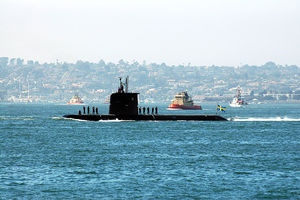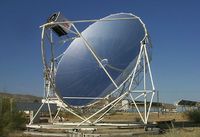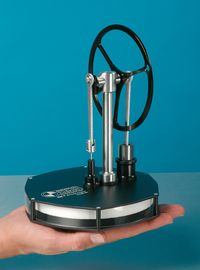Stirling engine: Difference between revisions
J.williams (talk | contribs) m (1 revision imported) |
No edit summary |
||
| Line 1: | Line 1: | ||
[[Category:Done | [[Category:Done 2018-06-15]] | ||
[[File:Gotland.jpg|300px|thumb|Figure 1. Gotland class submarines | [[File:Gotland.jpg|300px|thumb|Figure 1. Gotland class submarines use Stirling engines.<ref>Wikimedia Commons [Online]. (June 4 2015). Available: http://en.wikipedia.org/wiki/Gotland-class_submarine#/media/File:Swedish_attack_submarine_HMS_Gotland.jpg</ref>]] | ||
<onlyinclude>'''Stirling engines''' are a type of [[reciprocating engine|reciprocating]] [[external heat engine]] that uses one or more [[piston]]s to achieve useful [[work]] through some input of [[heat]] from an [[external combustion engine|external]] source. They differ vastly from [[internal combustion engine]]s that are seen in most vehicles.</onlyinclude> Stirling engines use the same [[gas]] over and over, unlike internal combustion engines which constantly intake and exhaust the gas. Also, Stirling engines do not use explosions like normal [[gasoline]] engines, therefore they are very quiet.<ref name=hsw>How Stuff Works, ''How Stirling Engines Work'' [Online], Available: http://auto.howstuffworks.com/stirling-engine.htm</ref> | <onlyinclude>'''Stirling engines''' are a type of [[reciprocating engine|reciprocating]] [[external heat engine]] that uses one or more [[piston]]s to achieve useful [[work]] through some input of [[heat]] from an [[external combustion engine|external]] source. They differ vastly from [[internal combustion engine]]s that are seen in most vehicles.</onlyinclude> Stirling engines use the same [[gas]] over and over, unlike internal combustion engines which constantly intake and exhaust the gas. Also, Stirling engines do not use explosions like normal [[gasoline]] engines, therefore they are very quiet.<ref name=hsw>How Stuff Works, ''How Stirling Engines Work'' [Online], Available: http://auto.howstuffworks.com/stirling-engine.htm</ref> | ||
Although these seem like major advantages to an ordinary engine, they | Although these seem like major advantages to an ordinary engine, they are less practical in most vehicles because they require ''external'' heat, rather than ''internal'' heat. The external source of hit needs extra time for the heat get the inside of the engines. This heat transfer makes the engine far less responsive than internal combustion engines.<ref name=hsw/> Stirling engines have also been found to be largely impractical in [[power plant]]s; Stirling engines have low [[specific power]], meaning that the engine has to be quite large in order to produce a relatively small amount of power.<ref>Electropaedia, ''The Stirling Engine'' [Online], Available: http://www.mpoweruk.com/stirling_engine.htm</ref> | ||
==Operation== | ==Operation== | ||
The key unique characteristic of Stirling engines is that there is a '''fixed amount of gas inside'''.<ref name=hsw/> | The key unique characteristic of Stirling engines is that there is a '''fixed amount of gas inside'''.<ref name=hsw/> The pressure of the gas can be manipulated by adding or removing heat. Adding heat will increase the pressure (and temperature)—in contrast, removing heat will decrease the pressure (and temperature). By changing how these two processes are done, the engine can be made to deliver useful work. The engine follows the "Stirling cycle" described below in a general form and can be seen in Figure 2. The cycle is as follows:<ref name=hsw/> | ||
#'''Heating and expansion'''- Heat is input from an external source, raising the temperature and therefore pressure of the gas. This causes a piston to expand and provide '''useful work.''' | #'''Heating and expansion'''- Heat is input from an external source, raising the temperature and therefore pressure of the gas. This causes a piston to expand and provide '''useful work.''' | ||
| Line 26: | Line 26: | ||
[[File:EuroDishSBP_front.jpg|200px|thumb|Figure 3. A Stirling engine, as seen in the center of this parabolic mirror, can be heated by the Sun.<ref>Wikimedia Commons [Online]. (June 4 2015). Available: http://upload.wikimedia.org/wikipedia/commons/e/ed/EuroDishSBP_front.jpg</ref>]] | [[File:EuroDishSBP_front.jpg|200px|thumb|Figure 3. A Stirling engine, as seen in the center of this parabolic mirror, can be heated by the Sun.<ref>Wikimedia Commons [Online]. (June 4 2015). Available: http://upload.wikimedia.org/wikipedia/commons/e/ed/EuroDishSBP_front.jpg</ref>]] | ||
[[File:MM-7_Stirling_Engine.jpg|200px|thumb|Figure 4. A Low temperature differential (LTD) Stirling engine, can generate around 1 W of power from a person's palm.<ref> | [[File:MM-7_Stirling_Engine.jpg|200px|thumb|Figure 4. A Low temperature differential (LTD) Stirling engine, can generate around 1 W of power from a person's palm.<ref>By Arsdell [GFDL (http://www.gnu.org/copyleft/fdl.html) or CC BY-SA 3.0 (https://creativecommons.org/licenses/by-sa/3.0)], from Wikimedia Commons</ref>]] | ||
*'''Cogeneration''' ('''CHP''')- In a [[cogeneration]] unit, a Stirling engine can make use of [[waste heat]] that is produced due to the [[second law of thermodynamics]]. This waste heat can go towards powering the Stirling engine for industrial or agricultural processes. | *'''Cogeneration''' ('''CHP''')- In a [[cogeneration]] unit, a Stirling engine can make use of [[waste heat]] that is produced due to the [[second law of thermodynamics]]. This waste heat can go towards powering the Stirling engine for industrial or agricultural processes. | ||
| Line 39: | Line 39: | ||
The U.S. has also developed a Stirling engine to generate electricity for use in space exploration. | The U.S. has also developed a Stirling engine to generate electricity for use in space exploration. | ||
==For Further Reading== | |||
*[[External combustion engine]] | |||
*[[Heat engine]] | |||
*[[Solar power]] | |||
*[[Nuclear power]] | |||
*[[Cogeneration]] | |||
*Or explore a [[Special:Random|random page]] | |||
==References== | ==References== | ||
{{reflist}} | {{reflist}} | ||
[[Category:Uploaded]] | [[Category:Uploaded]] | ||
Revision as of 01:36, 9 June 2018

Stirling engines are a type of reciprocating external heat engine that uses one or more pistons to achieve useful work through some input of heat from an external source. They differ vastly from internal combustion engines that are seen in most vehicles. Stirling engines use the same gas over and over, unlike internal combustion engines which constantly intake and exhaust the gas. Also, Stirling engines do not use explosions like normal gasoline engines, therefore they are very quiet.[2]
Although these seem like major advantages to an ordinary engine, they are less practical in most vehicles because they require external heat, rather than internal heat. The external source of hit needs extra time for the heat get the inside of the engines. This heat transfer makes the engine far less responsive than internal combustion engines.[2] Stirling engines have also been found to be largely impractical in power plants; Stirling engines have low specific power, meaning that the engine has to be quite large in order to produce a relatively small amount of power.[3]
Operation
The key unique characteristic of Stirling engines is that there is a fixed amount of gas inside.[2] The pressure of the gas can be manipulated by adding or removing heat. Adding heat will increase the pressure (and temperature)—in contrast, removing heat will decrease the pressure (and temperature). By changing how these two processes are done, the engine can be made to deliver useful work. The engine follows the "Stirling cycle" described below in a general form and can be seen in Figure 2. The cycle is as follows:[2]
- Heating and expansion- Heat is input from an external source, raising the temperature and therefore pressure of the gas. This causes a piston to expand and provide useful work.
- Flow and cooling- The piston moves up forcing the gas into another cylinder, where it is cooled. The cooling of the gas allows for easier compression, which means that less work is needed than was produced in step 1.
- Compression- The gas is now compressed, and the excess heat created from this compression is removed by the cooling source.
- Reverse flow and heating- The compressed gas moves back into the initial chamber where the cycle repeats.

The Stirling cycle can give more power by having a hotter source of heat in step 1, or by having a cooler cold sink in step 2.
Click here to learn about the different types of Stirling engines.
Application
Stirling engines have many applications:[5]


- Cogeneration (CHP)- In a cogeneration unit, a Stirling engine can make use of waste heat that is produced due to the second law of thermodynamics. This waste heat can go towards powering the Stirling engine for industrial or agricultural processes.
- Solar power generation- Placed at the focus of a parabolic mirror as seen in Figure 2, Stirling engines can convert solar energy to electricity with an efficiency better than some photovoltaic cells.
- Submarines- Stirling powered submarines can stay submerged much longer than conventional submarines. Swedish ship builder Kockums first installed Stirling engines in submarines, and with them the submarine doesn't have to surface to recharge its batteries, extending its submersion from days to weeks.[8]
- Nuclear power plants- There is potential for Stirling engines to replace steam turbines in nuclear reactors, and could increase the plant's efficiency and reduce radioactive by-products. These would use liquid sodium as coolant, and remove the need for water anywhere in the cycle.[5]
- Educational demonstration- A low temperature difference Stirling engine will run on any low temperature difference, for example the difference between the palm of a hand as seen in Figure 4.
The U.S. has also developed a Stirling engine to generate electricity for use in space exploration.
For Further Reading
- External combustion engine
- Heat engine
- Solar power
- Nuclear power
- Cogeneration
- Or explore a random page
References
- ↑ Wikimedia Commons [Online]. (June 4 2015). Available: http://en.wikipedia.org/wiki/Gotland-class_submarine#/media/File:Swedish_attack_submarine_HMS_Gotland.jpg
- ↑ 2.0 2.1 2.2 2.3 How Stuff Works, How Stirling Engines Work [Online], Available: http://auto.howstuffworks.com/stirling-engine.htm
- ↑ Electropaedia, The Stirling Engine [Online], Available: http://www.mpoweruk.com/stirling_engine.htm
- ↑ Made internally by a member of the Energy Education team
- ↑ 5.0 5.1 Stirling Shop. (June 4, 2015) Stirling engine - Applications [Online]. Available: http://stirlingshop.com/html/applications_.html
- ↑ Wikimedia Commons [Online]. (June 4 2015). Available: http://upload.wikimedia.org/wikipedia/commons/e/ed/EuroDishSBP_front.jpg
- ↑ By Arsdell [GFDL (http://www.gnu.org/copyleft/fdl.html) or CC BY-SA 3.0 (https://creativecommons.org/licenses/by-sa/3.0)], from Wikimedia Commons
- ↑ Saab. (June 4, 2015). The Stirling Engine [Online]. Available: http://saab.com/naval/Submarines-and-Warships/technologies/The-Stirling-Engine/

